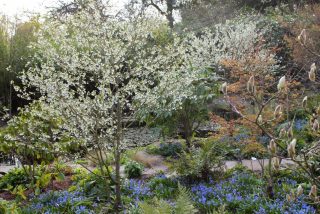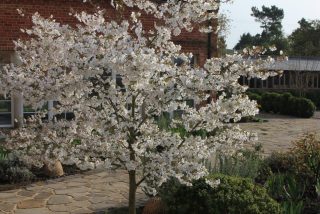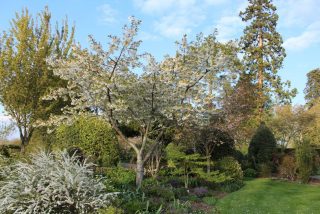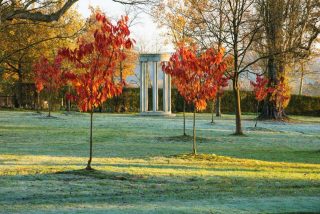Magical Cherry Blossom
The Japanese cherry blossom, or ‘Sakura’, attracts millions of people from across the globe each year. It is regarded as a symbol of renewal, vitality and beauty. It is a very short-lived spectacle, and, as with all things gardening, its timing is hugely dependent on the weather conditions. Imagine meticulously planning a very expensive trip to Japan only to miss the boat!
A cheaper and less stressful alternative is to create your own Sakura. Admittedly, this will be on a much smaller scale, but with the guarantee that you will be able to see it.
With carefully chosen varieties, it is possible to create a succession of beautiful blossom from late March to mid-May. As an added benefit, there is also spectacular colour in late autumn (saving you a second Japan trip).
At Morton Hall, the show kicks off in late March with Prunus incisa ‘Yamadei’, a small, umbrella-shaped tree with very small, single, bell-shaped, pure white flowers opening from green buds. Incisa cherries get their botanical name from the deep incisions on the leaves. The delicate flowers of the Yamadei cherry float cloud-like above the tapestry of scilla and hellebores in the Stroll Garden.

The next cherry to flower in early April is also an incisa variety, Prunus incisa ‘The Bride’ in the West Garden. This small tree is aptly named as it is densely packed with large single white flowers which would make a first-rate bridal veil.

The incisa cherries are closely followed by Prunus ‘Snow Goose’, a taller, very upright cherry with single white flowers and the famous Yoshino Cherry, Prunus × yedoensis 'Somei-yoshino', one of queens of the Sakura. In the New Garden, there is a romantic grove of these elegant trees, with their broad-spreading branches and large, single white or lightly pink scented flowers.

The display in the West Garden is carried on by Prunus ‘Shirotae’, which is also referred to as ‘Mount Fuji’. Here, the foliage appears first as a green fringe, swiftly followed by a combination of large single and semi-double pure white flowers. The crown of this stunning variety is gently weeping and can develop almost horizontal branches in mature specimen.

The finale of the West Garden cherry festival is marked by Prunus ‘Taihaku’, the ‘Great White Cherry’. It is famous not only for its beauty, but also for the fact that, having become extinct in Japan, it was saved by Collingwood "Cherry" Ingram, a British ornithologist, plant collector and gardener. On a trip to Japan in 1926, he was shown a painting of the lost cherry and recognised it as one he had seen in a Sussex garden. The tree, which was coming to the end of its life had been brought to England by a plant hunter. Ingram had taken cuttings and so was able to reintroduce it to its homeland.
‘Taihaku’ is a medium-sized tree with a broad spreading crown. The foliage appears first with young leaves of a deep bronze-red colour which turns green later. The large single flowers are pure white, and the combination of foliage and bloom makes this tree a majestic specimen.

Elsewhere in the garden, there are later-flowering varieties, such as Prunus ‘Shirofugen’. This cherry has beautiful double white flowers, which gradually turn pink. The young foliage is coppery in colour, which makes an interesting contrast to the pink flowers. It turns green later and then orange in the autumn time, joining the fiery acers in the Stroll Garden.

Another late-flowering variety which produces white flowers that turn slightly pink is Prunus ‘Fragrant Cloud’, which we have planted as an informal alley leading to the Monopteros in the Parkland Meadow. In November, these cherries turn deep red which looks wonderful against the white sandstone of the Monopteros.

‘Sakura’ at Morton Hall Gardens!
